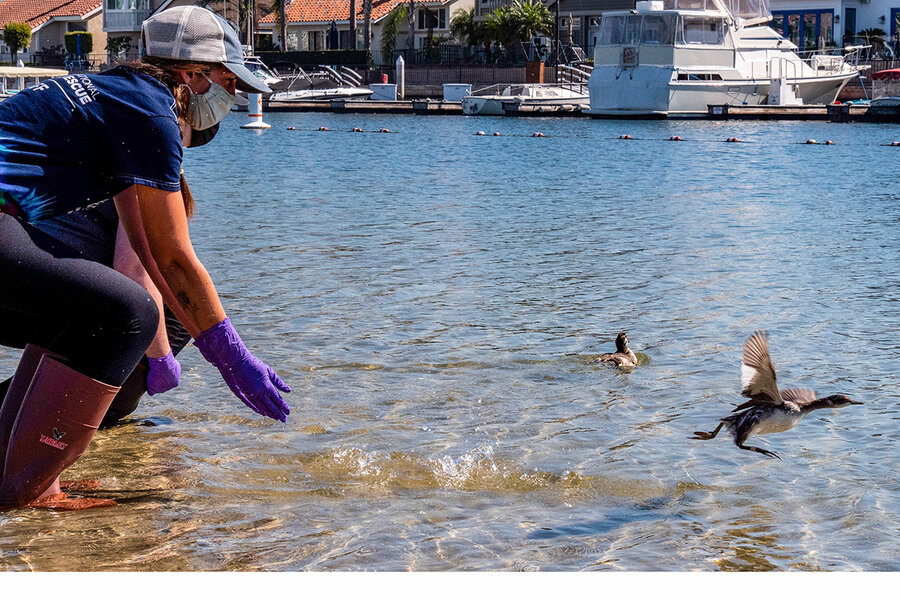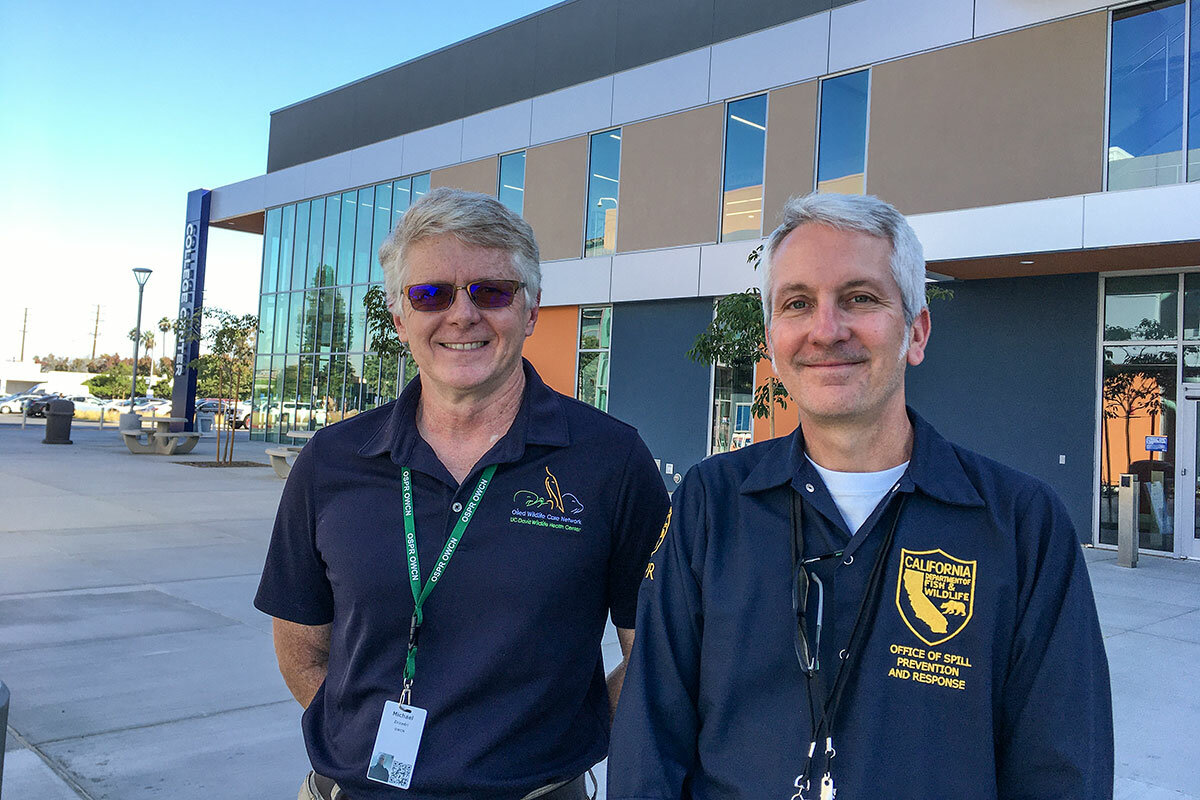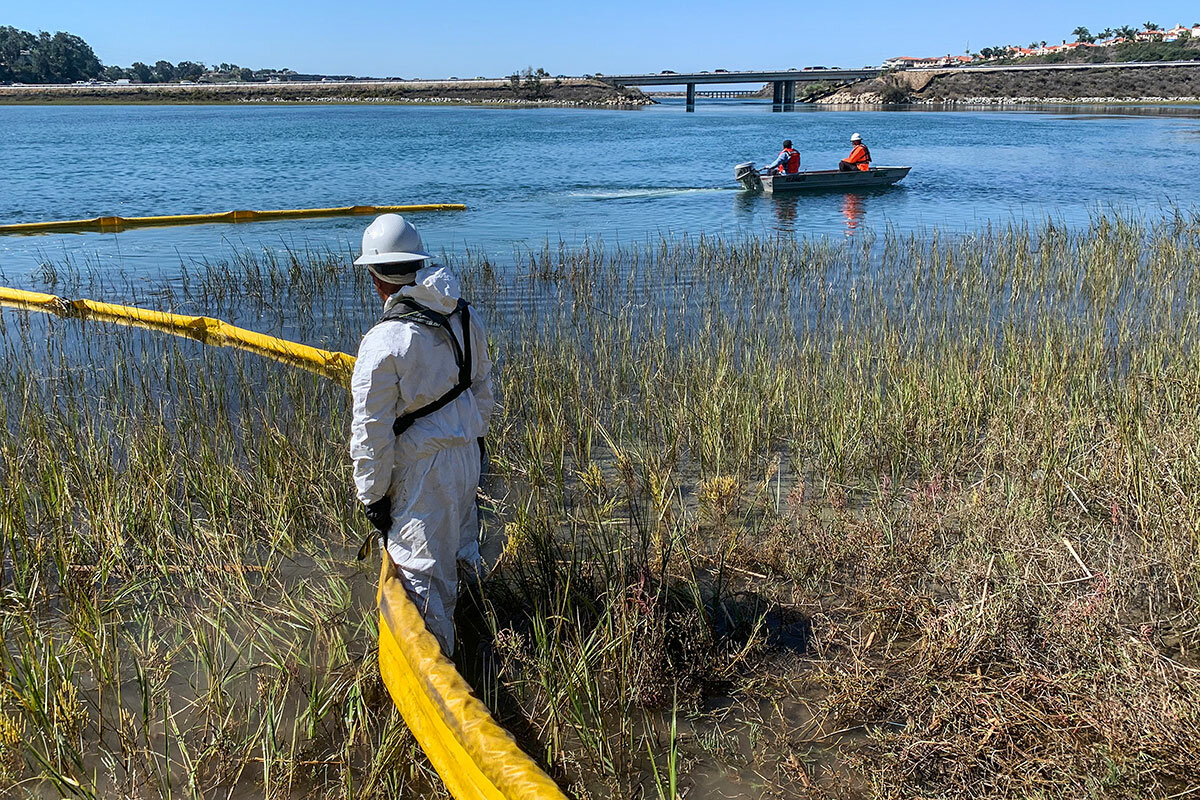California oil spill: Improved odds for animals caught in crude
Loading...
| COSTA MESA, CALIF.
It was a joyous occasion. On Oct. 13, two birds – a ruddy duck and an eared grebe – were the first to be released after being rescued from an oil spill in the coastal waters of Southern California. Set free at a small beach in placid Huntington Harbor, the recovered grebe, once heavily oiled, immediately took flight. The duck, also formerly coated with crude, paddled and bobbed, oblivious to crouching photographers and television cameras on shore.
The first planned release of recovered wildlife is “like a turning point” in an oil spill, says Michael Ziccardi, director of the Oiled Wildlife Care Network, which is tasked with coordinating oiled wildlife response to the Oct. 2 spill. The release is also a testament to the increased rate of wildlife survival after such incidents, generally a 50% to 75% success rate for treated, captured animals until the time of their release, up from a 25% to 50% rate in the early 1990s, he says. He attributes much of the progress to readiness. “The level of preparedness now, versus 20 years ago, is tremendous.”
On the morning of the release, Dr. Ziccardi, a veterinarian, and Laird Henkel, a senior environmental scientist in the California Department of Fish and Wildlife’s Office of Spill Prevention and Response, sat down with the Monitor to talk about the improvement in the survivability of animals recovered from oil spills. Mr. Henkel directed the wildlife response for this event. The two are relieved that the leak is not as bad as first feared. Estimates of oil released from a torn underwater pipeline owned by Amplify Energy have been revised downward, from potentially 144,000 gallons to 25,000, according to the U.S. Coast Guard. Beaches have reopened, aided by crews picking up tar balls and by ocean currents, wind, and wave action.
Why We Wrote This
Faster response times and dedicated resources are improving the odds for wildlife caught up in environmental disasters. We take a look behind the scenes to see what’s led to this progress.
“We all feel very fortunate that it appears that the overall abundance of wildlife out there on the ocean and on the beaches was really low,” Mr. Henkel says, noting that it was neither breeding nor migration season. Only 111 wildlife were collected from the three affected counties – Los Angeles, Orange, and San Diego – the vast majority of them birds. Of the birds collected, 74 were dead, but 32 were alive – including 7 snowy plovers, a threatened species of small shorebird. As of Monday, 10 birds had been released.
The extent of the damage was unknown when Mr. Henkel first got the call about the spill midday on Oct. 2, a Saturday. But because protocols, a response network, and care facilities were already in place, teams could be activated quickly and forcefully. Four regional facilities were put on standby – two for birds and two for mammals – with one for each group serving as a “MASH” unit for immediate stabilization before transport to a primary care facility. Vehicles and personnel began rolling at 4 a.m. Sunday from the University of California, Davis, where Dr. Ziccardi’s office is based in the veterinary school. By first light Sunday, two teams from the Los Angeles Oiled Bird Care and Education Center were on the scene. The facility, near the Port of Los Angeles in San Pedro, is the primary care center for the birds from this spill – one of 12 facilities up and down the state designated for care of oiled wildlife.
So far, no marine mammals have been collected for treatment from this spill. Unlike furry sea otters, which don’t live this far south, other marine mammals are less susceptible than birds, though cetaceans like whales and dolphins can breathe in harmful vapors from oil, says Mr. Henkel.
On the other hand, oil interferes with a bird’s alignment of feathers that allows them to stay afloat, dry, and warm. It weighs them down and weakens them as they expend more energy to move and maintain their body temperature. They seek warmth by beaching themselves, but then they lose their access to food. At the Los Angeles bird care center, they are cleaned with a solvent, dish soap, and warm water. Dr. Ziccardi says the more recent practice of bringing oiled wildlife first to a “MASH” station to get warm, hydrated, and have a little more time has made a big difference.
“We’ve actually got reports from our facility people with the birds coming in to them. They say that they’re in amazing shape when they arrive, just because of the care they’re getting early.”
It wasn’t always this way. The two men explain that the massive Exxon Valdez oil tanker spill in Alaska’s Prince William Sound in 1989 and the 1990 American Trader oil tanker spill off Huntington Beach – the same area as this spill – triggered a major shift in attitude in industry and government, spurred on by public opinion.
Congress quickly moved to pass the U.S. Oil Pollution Act of 1990, which mandates that wildlife protection and rehabilitation be part of oil spill contingency plans. But the California Legislature went much further that year, setting up a detailed framework for response, including facilities for oiled wildlife care. This led to the 1994 founding of Dr. Ziccardi’s Oiled Wildlife Care Network, which draws on help from 1,600 trained volunteers and 44 member organizations to help in California oil spills. “In California, public opinion after those big spills in ’89 and ’90 really helped,” says Mr. Henkel.
No other state comes even close to California’s systematic approach and its dozen facilities, says Dr. Ziccardi, who worked on the 2010 Deep Water Horizon spill in the Gulf of Mexico for five months. Texas has one purpose-built facility for oiled wildlife, and Delaware has one, he says. “That is it.”
Dr. Ziccardi chairs the Global Oil Wildlife Response System, a consortium of 11 leading wildlife groups that do worldwide response. And Europe has pulled together groups in several countries to come up with standardized protocols and training. “But it would be hard to argue the fact that California is the best-prepared place in the world for spill response,” he says.
Triage for oiled animals has its critics in the scientific community. As the world focused on the Deepwater disaster, for instance, German biologist Silvia Gauss argued it was kinder and made more sense to euthanize oiled birds than to clean and release them. She said studies of oiled birds after they are released show midterm survival is less than 1%. In addition to long-term health risks, the stress of being caught and cleaned can be fatal, she said.
But in a 2018 article in the Journal of Fish and Wildlife Management, Mr. Henkel and Dr. Ziccardi argue otherwise. They point to variability among studies, and write that post-release survival can “far exceed” lower results that compare released oiled birds with control groups of non-oiled birds. In studies of penguins and pelicans, there was no difference, they write.
After the 1990 American Trader oil spill, a post-release study of brown pelicans funded by Dr. Ziccardi’s group found significant mortality. But after the Refugio oil spill in Santa Barbara County 25 years later, and using better tracking technology, Dr. Ziccardi says there was no statistical difference in survivability between oiled brown pelicans that were treated and released and a control group of non-oiled brown pelicans.
In the interview, Dr. Ziccardi explains that survival data is “a little messy.” Much depends on the type of oil spill, the speed of response, and the kind of bird – whether it is a robust species or not. Seven of the 32 recovered birds in this spill have had to be euthanized, and two died in care – still a short-term survivability rate of 72%. Dr. Ziccardi says he wants to continue to learn from each spill and improve procedures. Some people may think oiled wildlife recovery is not worthwhile, he says, but “data shows that it does make a difference.”








